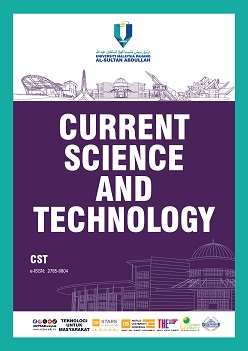Study on the Relations of Ionic Conductivity and Transport Properties of Alginate-PVA Based Bio-Polymer Blend Electrolytes System
DOI:
https://doi.org/10.15282/cst.v3i2.10370Keywords:
Biopolymer blend, Dielectric response, Conduction mechanism, Ionic transportsAbstract
The growing interest in green energy storage materials has led to a renewed focus on creating biopolymer materials as electrolytes for electrochemical devices. In addition to being environmentally benign, it may result in lower costs and many financial prospects. This study sheds light on the protonation process of bio-polymer blend electrolytes based on alginate-poly (vinyl alcohol) (Alg-PVA) synthesized using the solution cast method and doped with varying concentrations of ammonium sulphate (NH4)2SO4. The impedance spectroscopy obtained the Cole-Cole plot, and the bulk resistance value decreased when (NH4)2SO4 was added. The calculated ionic conductivity showed the optimum value at 1.26 × 10-4 S cm-1 for a sample containing 15 wt.% of (NH4)2SO4. The dielectric responses were used to assess the transport parameters of ion conduction, and it was shown that the principal causes of the increase in ionic conductivity are increased ion mobility and diffusion coefficient caused by the addition of (NH4)2SO4.
References
[1] K. S. Ngai, S. Ramesh, K. Ramesh and J. C. Juan, “A review of polymer electrolytes: Fundamental, approaches and applications,” Ionics, vol. 22, pp. 1259-1279, 2016.
[2] S. N. A. M. Johari, N. A. Tajuddin, H. Hanibah and S. K. Deraman, “A review: ionic conductivity of solid polymer electrolyte-based polyethylene oxide,” International Journal of Electrochemical Science, vol. 16, no. 10, p. 211049, 2021.
[3] N. F. Mazuki, A. P. P. A. Majeed, Y. Nagao and A. S. Samsudin Mazuki, “Studies on ionics conduction properties of modification CMC-PVA based polymer blend electrolytes via impedance approach,” Polymer Testing, vol. 81, p. 106234, 2020.
[4] A. F. Fuzlin, I. I. Misnon, Y. Nagao and A. S. Samsudin “Study on ionic conduction of alginate bio-based polymer electrolytes by incorporating ionic liquid, Materials Today: Proceedings, vol. 51, pp. 1455-1459, 2022.
[5] N. M. Ghazali, A. F. Fuzlin, M. A. Saadiah, M. M. Hasan, Y. Nagao and A. S. Samsudin, “Studies on H+ ions conducting bio-polymer blend electrolyte based on alginate-PVA doped with NH4NO3,” Journal of Non-Crystalline Solids, vol. 598, p. 121939, 2022.
[6] A. F. Fuzlin, M. A. Saadiah, Y. Yao, Y. Nagao and A. S. Samsudin, “Enhancing proton conductivity of sodium alginate doped with glycolic acid in bio-based polymer electrolytes system,” Journal of Polymer Research, vol. 27, pp. 1–16, 2020.
[7] A. Zulkifli, M. A. Saadiah, N. F. Mazuki and A.S. Samsudin, “Characterization of an amorphous materials hybrid polymer electrolyte based on a LiNO3-doped, CMC-PVA blend for application in an electrical double layer capacitor,” Materials Chemistry and Physics, vol. 253, p. 123312, 2020.
[8] M. A. Saadiah, Y. Nagao and A. S. Samsudin, “Proton (H+) transport properties of CMC–PVA blended polymer solid electrolyte doped with NH4NO3,” International Journal of Hydrogen Energy, vol. 45, no. 29, pp. 14880–14896, 2020.
[9] S. B. Aziz, E. M. A. Dannoun, A. R. Murad, K. H. Mahmoud, M. A. Brza, M. M. Nofal, et al., “Influence of scan rate on CV Pattern: Electrical and electrochemical properties of plasticized Methylcellulose: Dextran (MC:Dex) proton conducting polymer electrolytes,” Alexandria Engineering Journal, vol. 61, no. 8, pp. 5919–5937, 2022.
[10] S. B. Aziz, R. T. Abdulwahid, M. H. Hamsan, M. A. Brza, R. M. Abdullah, M. F. Kadir, et al., “Structural, impedance, and EDLC characteristics of proton conducting chitosan-based polymer blend electrolytes with high electrochemical stability,” Molecules, vol. 24, no. 19, pp. 1–15, 2019.
[11] M. Ates, Y. Bayrak, H. Ozkan, O. Yoruk, M. Yildirim and O. Kuzgun, “Synthesis of rGO/TiO 2 /PEDOT nanocomposites, supercapacitor device performances and equivalent electrical circuit models,” Journal of Polymer Research, vol. 26, pp. 1-16, 2019.
[12] H. T. Ahmed and O. G. Abdullah, “Structural and ionic conductivity characterization of PEO:MC-NH4I proton-conducting polymer blend electrolytes-based films,” Results in Physics, vol. 16, p. 102861, 2020.
[13] Y. Li, F. Ding, Z. Xu, L. Sang, L. Ren, W. Ni, et al., “Ambient temperature solid-state Li-battery based on high-salt-concentrated solid polymeric electrolyte,” Journal of Power Sources, vol. 397, pp. 95–101, 2018.
[14] M. F. Shukur, R. Ithnin, H. A. Illias and M. F. Z. Kadir, “Proton conducting polymer electrolyte based on plasticized chitosan-PEO blend and application in electrochemical devices,” Optical Materials, vol. 35, no. 10, pp. 1834–1841, 2013.
Downloads
Published
Issue
Section
License
Copyright (c) 2023 The Author(s)

This work is licensed under a Creative Commons Attribution-NonCommercial 4.0 International License.



